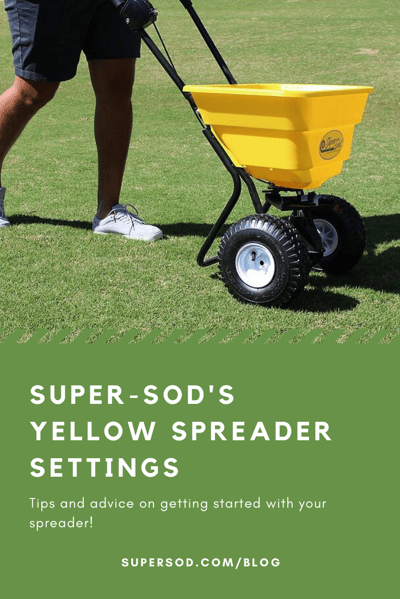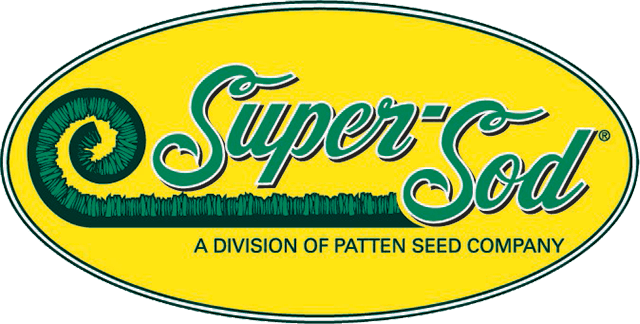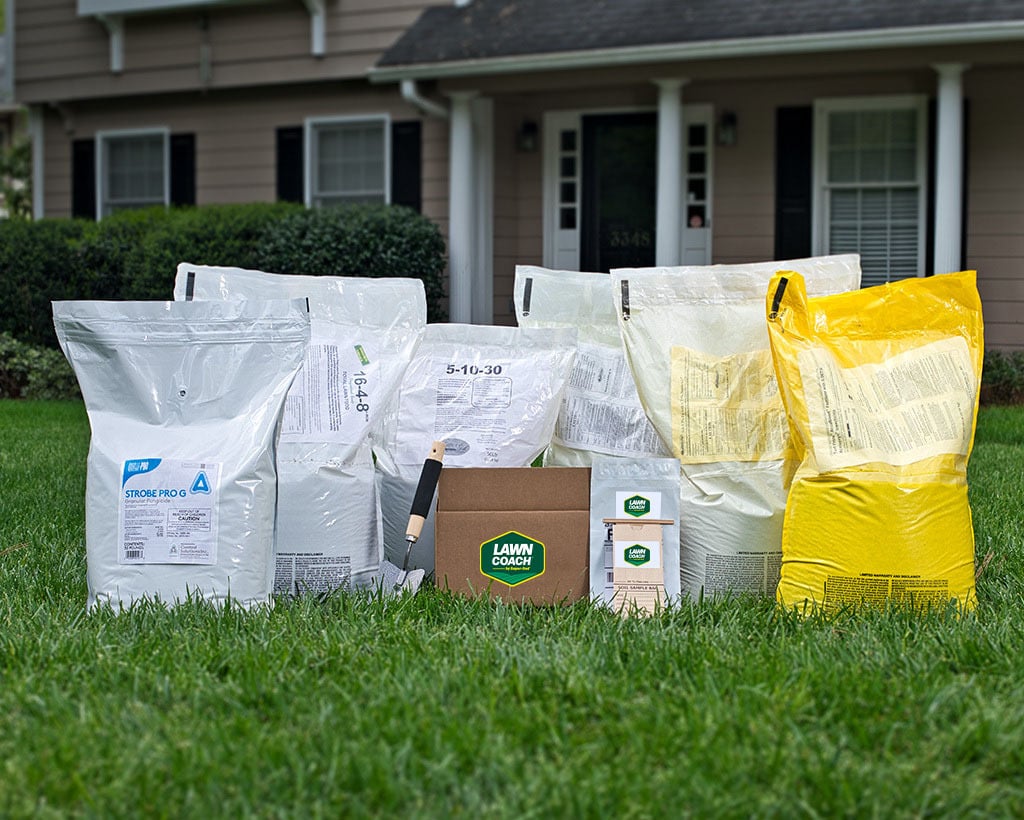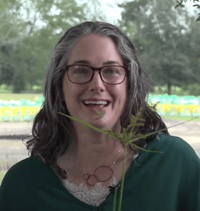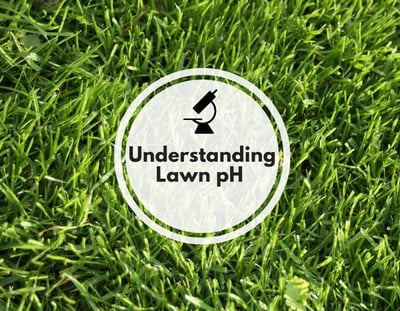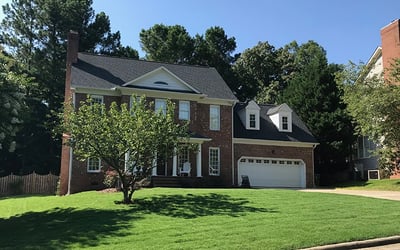
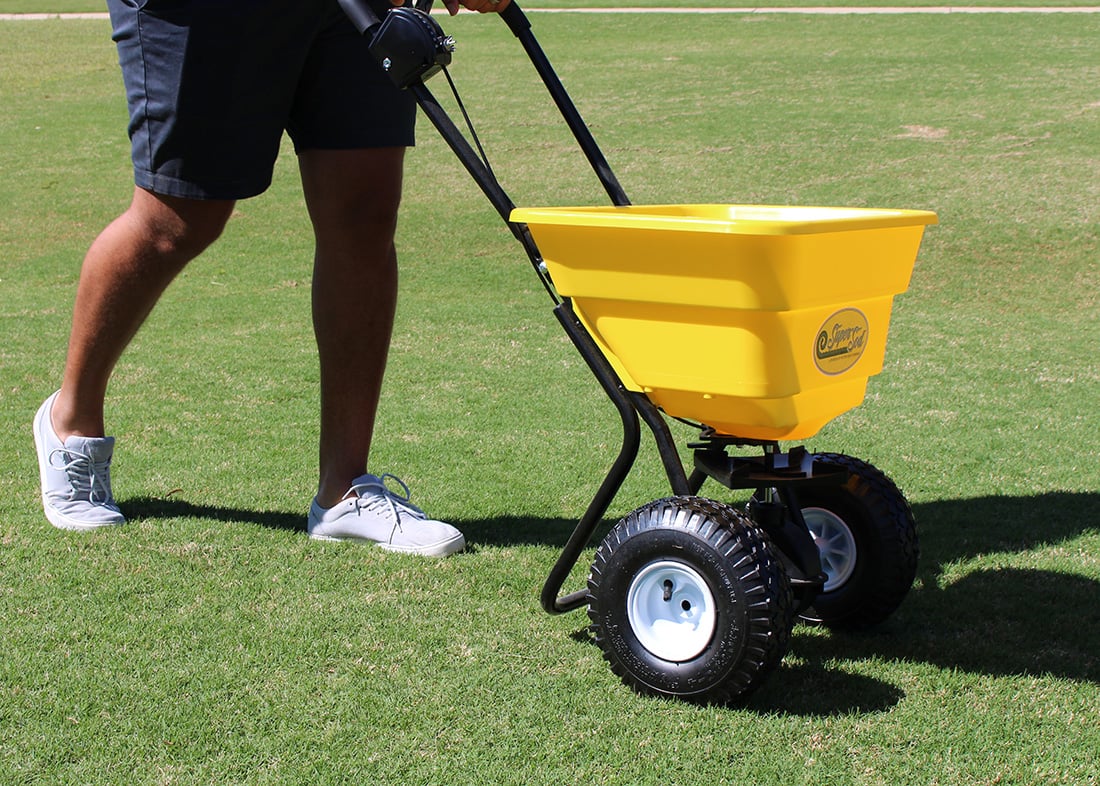
Our Yellow Spreader Settings
- Click here for a printable pdf of our yellow spreader settings.
- Look up product recommendations and application schedules for your lawn type in our Maintenance Guides.
Walk-Behind Yellow Spreader Settings |
||
| Fertilizer | Rate | Setting |
| 5-10-30 + Iron | 5 lbs./1,000 sq.ft. | 17 |
| 16-4-8 + Iron | 6 lbs./1,000 sq.ft. | 18 |
| 18-24-12 + Iron | 6 lbs./1,000 sq.ft. | 18 |
| 1-0-1 Granulated Iron | 5 lbs./1,000 sq.ft. | 17 |
| Pre-Emergent | Rate | Setting |
| 0-0-7 + Pre-Emergent Herbicide | 6 lbs./1,000 sq.ft. | 18 |
| 16-4-8 + Pre-Emergent Herbicide | 6 lbs./1,000 sq.ft. | 18 |
| Fungicide | Rate | Setting |
| Professional Grade Fungicide (such as Strobe+ G)* |
2-3 lbs./1,000 sq.ft. | 10-11 |
| Insecticide | Rate | Setting |
| 5-10-30 + Acelepryn Insecticide | 5 lbs./1,000 sq.ft. | 17 |
| Imidacloprid (such as Grub-No-More) | 2 lbs./1,000 sq.ft. | 12 |
| Broad Spectrum Insecticide (such as Talstar)** | 2-5 lbs./1,000 sq.ft. | 12-15 |
| Soil Amendment | Rate | Setting |
| Fast Acting Lime | 6 lbs./1,000 sq.ft. | 18 |
| Seed | Rate | Setting |
| Elite Tall Fescue - Overseeding | 5 lbs./1,000 sq.ft. | 18 |
| Elite Tall Fescue - New Lawn | 8 lbs./1,000 sq.ft. | 20 |
| Zenith Zoysia Seed | 1 lbs./1,000 sq.ft. | 5 |
| TifBlair Centipede Seed | .5 lbs./1,000 sq.ft. | 4 |
|
|
||
Hand-Held Yellow Spreader Settings |
||
| Seed | Rate | Setting |
| Zenith Zoysia Seed | 1 lbs./1,000 sq.ft. | 1.5 |
| TifBlair Centipede Seed | .5 lbs./1,000 sq.ft. | 1.1 |
| Elite Tall Fescue Seed | 8 lbs./1,000 sq.ft. | 3 |
The settings listed are intended for general reference only for our yellow spreaders. This reference list doesn't apply to settings for other spreader brands. The setting numbers listed should be used as a starting point and adjustments might need to be made based on each user’s walking speed and machine; for the hand-held spreader it also depends on how fast the handle is turned and how high the spreader is held. Spreaders can wear and fertilizers change density over time so always double check your settings. Super-Sod makes no warranty to the uniformity of coverage and cannot be held responsible for misapplication or damage caused by the products listed. Products we offer may change and be replaced in this list.
Yellow Spreader Features
Walk-Behind Spreader
Our pushed yellow spreader comes with a 1-year warranty and can be ordered in our lawn store. It's the best choice for lawn care and its features include:
- 80 lb. capacity hopper with rustproof poly construction
- 10” pneumatic tires on rustproof poly rims for smooth operation
- 3-hole drop shut-off system and heavy-duty gearbox to ensure an even application of all granular materials
- SideSpred-ControlTM can be engaged to block part of the distribution pattern for better control along edges such as driveway and flower beds.
Hand-Held Spreader
Our hand-held spreader is the spreader size we recommend for planting Zenith Zoysia and TifBlair Centipede seeds. It can be ordered in our lawn store too. For all other granular products we recommend the walk-behind spreader.
Other Spreaders
How-to Calibrate Other Spreaders
- Calculate how much product you will need:
- I figure out how many square feet my total lawn area covers.
- Determine the application rate for the product - how many pounds per 1,000 square feet.
- For this example, the recommended application rate for preventing fungus is 2 lbs. of Strobe Pro G per 1,000 square feet.
- Do the math! My yard is 3,000 square feet, so I will need to apply 6 lbs. of Strobe Pro G. (3,000 square feet x 2 lbs. per 1,000 sf. = 6 lbs.)
- Head to a local Super-Sod store and purchase the lawn treatment product.
- Perform a 1,000 square foot test:
- Measure out a 1,000 square feet area of yard for applying product as your initial calibration test.
- Measure out how many pounds of lawn treatment product are needed. You can use a kitchen scale or stand on your bathroom scale with a bucket of lawn product and then subtract your weight with just an empty bucket.
- Then I "choke down" the opening of my spreader to allow just enough of the product to pass through. I don't want to apply too much to one area. The opening size really depends on the granule size of the product being spread. Since Strobe Pro G is a fine granule, you'll want just a slight opening. Another example is our 0-0-7 fertilizer with pre-emergent herbicide which is a larger granule, so you'll want the opening to be a bit wider to allow the product to pass through.
- Apply the product to the 1,000 square feet test area.
- Adjust the spreader setting:
- Is there any product left in the hopper after completing your pass over the 1,000 square feet? If yes, you will have to go over the area again to disperse the rest of the product.
- Now you will have a feel for how much more you can increase the opening in the hopper of your spreader to apply the remaining product that you measured out for the rest of your yard.
- If you ran out of product before you completed the 1,000 square feet test, then reduce the size of the opening.
- Record your final calibrated settings:
- After you calibrate for and apply a granular product, make a note so the next time you apply it you'll have your setting already. Make sure to note the product name and the corresponding number setting on your spreader.
- Record the information in your phone, hang it on a note board in your garage, write on a piece of tape you stick directly on your spreader – whatever method works for you.
As you can see, the calibration process can be quite tedious! That’s why we have done the work for you with our yellow spreaders.
Pro-Tip: Make 2 Half-Rate Passes
Best practice to ensure even coverage on your lawn is to apply the product in two passes: first half is applied in north-south direction and the second half in a pass going east-west. Once you know the settings for your spreader, make sure you are using the setting for applying half of the total recommended amount of lawn treatment product for each pass.
For the above example, my goal is to spread 2 lbs. of Strobe Pro G per 1,000 square feet to the entire area. If I am using the half-rate or two-pass method, then I need to apply 1 lb. per 1,000 square feet each time. So I need to remember to adjust the spreader setting for half of the recommended product application rate. Earlier we calculated that I need to apply 6 lbs. in total for my 3,000 square feet lawn – I will apply 3 lbs. in one direction and the other 3 lbs. in the opposite direction to get uniform coverage.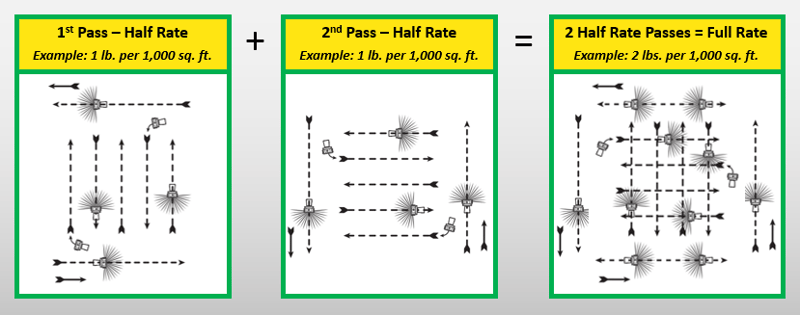 Half-Rate Spread Path Diagram by Earthway Products, Inc.
Half-Rate Spread Path Diagram by Earthway Products, Inc.
Avoid Cheap Spreaders
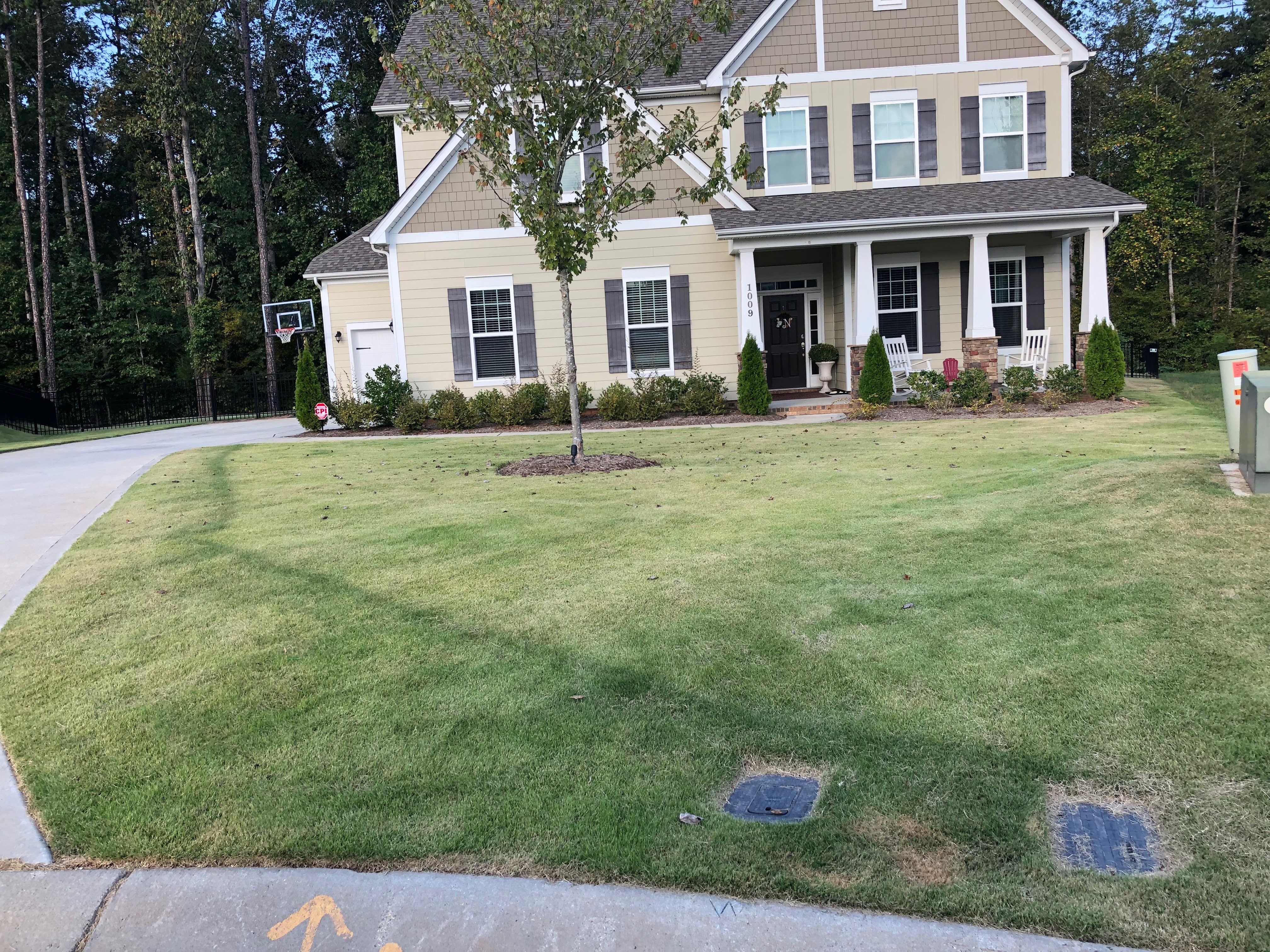
Purge Broken Spreaders
Go with Super-Sod's Yellow Spreader!
Now that you know more about broadcast spreaders than you ever thought possible, you can consider yourself a pro on this topic. Help "spread" the word about quality spreaders and proper calibration by sharing and bookmarking this page for future reference.
Our yellow spreaders can be purchased at all Super-Sod stores and ordered online.
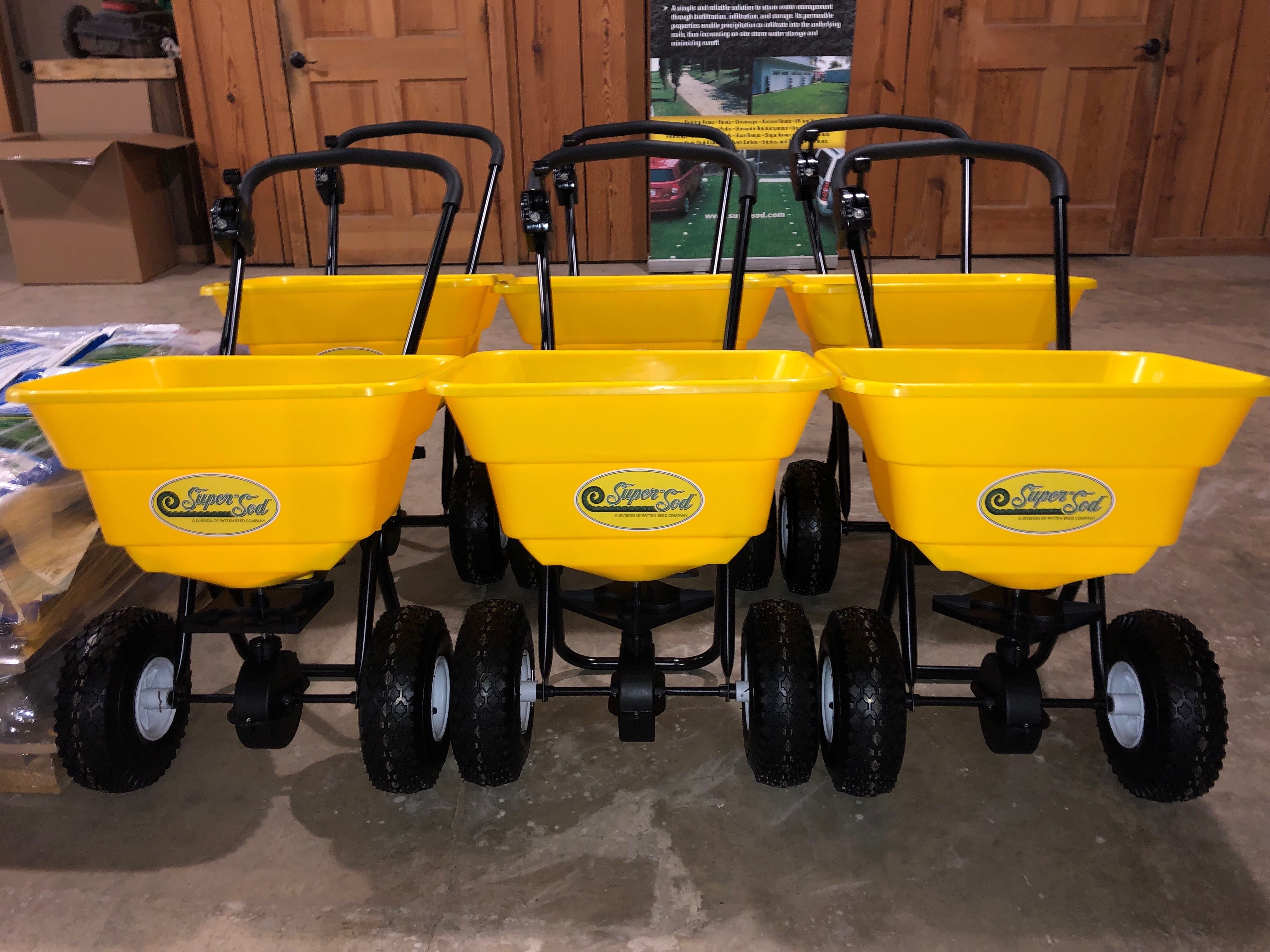
Armed with the Super-Sod walk-behind yellow spreader, the spreader setting chart (above), lawn treatment products from your local Super-Sod store, and our monthly lawn tips email - you can have the lawn of your dreams!